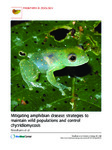Mitigating amphibian disease: strategies to maintain wild populations and control chytridiomycosis
| dc.contributor.author | Woodhams, DC | |
| dc.contributor.author | Bosch, J | |
| dc.contributor.author | Briggs, CJ | |
| dc.contributor.author | Cashins, S | |
| dc.contributor.author | Davis, LR | |
| dc.contributor.author | Lauer, A | |
| dc.contributor.author | Muths, E | |
| dc.contributor.author | Puschendorf, Robert | |
| dc.contributor.author | Schmidt, BR | |
| dc.contributor.author | Sheafor, B | |
| dc.contributor.author | Voyles, J | |
| dc.date.accessioned | 2020-08-24T11:59:59Z | |
| dc.date.available | 2020-08-24T11:59:59Z | |
| dc.date.issued | 2011 | |
| dc.identifier.issn | 1742-9994 | |
| dc.identifier.issn | 1742-9994 | |
| dc.identifier.other | ARTN 8 | |
| dc.identifier.uri | http://hdl.handle.net/10026.1/16185 | |
| dc.description.abstract |
BACKGROUND: Rescuing amphibian diversity is an achievable conservation challenge. Disease mitigation is one essential component of population management. Here we assess existing disease mitigation strategies, some in early experimental stages, which focus on the globally emerging chytrid fungus Batrachochytrium dendrobatidis. We discuss the precedent for each strategy in systems ranging from agriculture to human medicine, and the outlook for each strategy in terms of research needs and long-term potential. RESULTS: We find that the effects of exposure to Batrachochytrium dendrobatidis occur on a spectrum from transient commensal to lethal pathogen. Management priorities are divided between (1) halting pathogen spread and developing survival assurance colonies, and (2) prophylactic or remedial disease treatment. Epidemiological models of chytridiomycosis suggest that mitigation strategies can control disease without eliminating the pathogen. Ecological ethics guide wildlife disease research, but several ethical questions remain for managing disease in the field. CONCLUSIONS: Because sustainable conservation of amphibians in nature is dependent on long-term population persistence and co-evolution with potentially lethal pathogens, we suggest that disease mitigation not focus exclusively on the elimination or containment of the pathogen, or on the captive breeding of amphibian hosts. Rather, successful disease mitigation must be context specific with epidemiologically informed strategies to manage already infected populations by decreasing pathogenicity and host susceptibility. We propose population level treatments based on three steps: first, identify mechanisms of disease suppression; second, parameterize epizootiological models of disease and population dynamics for testing under semi-natural conditions; and third, begin a process of adaptive management in field trials with natural populations. | |
| dc.format.extent | 8-8 | |
| dc.format.medium | Electronic | |
| dc.language | en | |
| dc.language.iso | eng | |
| dc.publisher | Springer Science and Business Media LLC | |
| dc.subject | Infectious Diseases | |
| dc.title | Mitigating amphibian disease: strategies to maintain wild populations and control chytridiomycosis | |
| dc.type | journal-article | |
| dc.type | Journal Article | |
| plymouth.author-url | https://www.webofscience.com/api/gateway?GWVersion=2&SrcApp=PARTNER_APP&SrcAuth=LinksAMR&KeyUT=WOS:000290856400001&DestLinkType=FullRecord&DestApp=ALL_WOS&UsrCustomerID=11bb513d99f797142bcfeffcc58ea008 | |
| plymouth.issue | 1 | |
| plymouth.volume | 8 | |
| plymouth.publication-status | Published | |
| plymouth.journal | Frontiers in Zoology | |
| dc.identifier.doi | 10.1186/1742-9994-8-8 | |
| plymouth.organisational-group | /Plymouth | |
| plymouth.organisational-group | /Plymouth/Faculty of Science and Engineering | |
| plymouth.organisational-group | /Plymouth/Faculty of Science and Engineering/School of Biological and Marine Sciences | |
| plymouth.organisational-group | /Plymouth/REF 2021 Researchers by UoA | |
| plymouth.organisational-group | /Plymouth/REF 2021 Researchers by UoA/UoA06 Agriculture, Veterinary and Food Science | |
| plymouth.organisational-group | /Plymouth/Users by role | |
| plymouth.organisational-group | /Plymouth/Users by role/Academics | |
| dc.publisher.place | England | |
| dcterms.dateAccepted | 2011-04-18 | |
| dc.identifier.eissn | 1742-9994 | |
| dc.rights.embargoperiod | Not known | |
| rioxxterms.versionofrecord | 10.1186/1742-9994-8-8 | |
| rioxxterms.licenseref.uri | http://www.rioxx.net/licenses/all-rights-reserved | |
| rioxxterms.licenseref.startdate | 2011-04-18 | |
| rioxxterms.type | Journal Article/Review |


